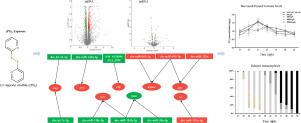Aquatic Toxicology ( IF 4.5 ) Pub Date : 2022-05-07 , DOI: 10.1016/j.aquatox.2022.106191 Hua Tian 1 , Wanyu Ba 1 , Xu Zhang 1 , Xue Wang 1 , Yifei Dong 1 , Xuefu Li 1 , Shaoguo Ru 1

|
This study was conducted to evaluate the thyroid-disrupting effects of 2,2′-dipyridyl disulfide using Japanese flounder (Paralichthys olivaceus) as an animal model and to reveal the underlying mechanisms from the perspective of miRNA-mRNA interactions. The results indicated that 2,2′-dipyridyl disulfide exposure decelerated the metamorphic progress of P. olivaceus, suggesting its thyroid-disrupting property as an antagonist. Furthermore, radioimmunoassays, thyroid histological observation, real-time polymerase chain reaction, and mRNA sequencing showed that 2,2′-dipyridyl disulfide exposure exerted its thyroid-disrupting effects on larval and juvenile P. olivaceus by targeting multiple processes and pathways involved in the thyroid system, including peripheral metabolism of thyroid hormones, the thyroid hormone synthesis pathway, and the thyroid hormone/thyroid hormone receptor signaling pathway. In particular, global upregulation of the gene expression of three deiodinases caused decreases in thyroid hormone levels after 2,2′-dipyridyl disulfide exposure that are believed to be responsible for the inhibition of metamorphosis in P. olivaceus. Finally, miRNA sequencing suggested that several evolutionarily conserved miRNAs play important roles in the mechanism of 2,2′-dipyridyl disulfide-induced thyroid disruption. Specifically, overexpression of pny-miR-723a and pny-miR-216a resulted in upregulation of deiodinase 1 mRNA levels in the 2,2′-dipyridyl disulfide exposure group. This study provides the first evidence that 2,2′-dipyridyl disulfide has thyroid-disrupting properties and is also the first study remarking on the roles of miRNA-mRNA interactions in the action mechanisms of thyroid disruptors.
中文翻译:

mRNA-miRNA 测序揭示了 2,2'-二吡啶基二硫化物诱导日本比目鱼 (Paralichthys olivaceus) 甲状腺破坏的机制
本研究以日本比目鱼 ( Paralichthys olivaceus ) 为动物模型,评估 2,2'-联吡啶二硫化物的甲状腺干扰作用,并从 miRNA-mRNA 相互作用的角度揭示其潜在机制。结果表明,2,2'-二吡啶基二硫化物暴露减缓了P. olivaceus的变质进程,表明其作为拮抗剂的甲状腺干扰特性。此外,放射免疫测定、甲状腺组织学观察、实时聚合酶链反应和 mRNA 测序表明,2,2'-二吡啶基二硫化物暴露对幼虫和幼体P. olivaceus具有破坏甲状腺的作用通过针对涉及甲状腺系统的多个过程和途径,包括甲状腺激素的外周代谢、甲状腺激素合成途径和甲状腺激素/甲状腺激素受体信号通路。特别是,三种脱碘酶基因表达的整体上调导致 2,2'-二吡啶基二硫化物暴露后甲状腺激素水平降低,这被认为是抑制橄榄假单胞菌变态的原因。最后,miRNA 测序表明,一些进化上保守的 miRNA 在 2,2'-二吡啶基二硫化物诱导的甲状腺破坏的机制中起重要作用。具体来说,pny-miR-723a 和 pny-miR-216a 的过表达导致脱碘酶 1的上调2,2'-二吡啶基二硫化物暴露组中的 mRNA 水平。本研究提供了第一个证据表明 2,2'-二吡啶基二硫化物具有甲状腺干扰特性,也是第一个评论 miRNA-mRNA 相互作用在甲状腺干扰物作用机制中的作用的研究。



























 京公网安备 11010802027423号
京公网安备 11010802027423号